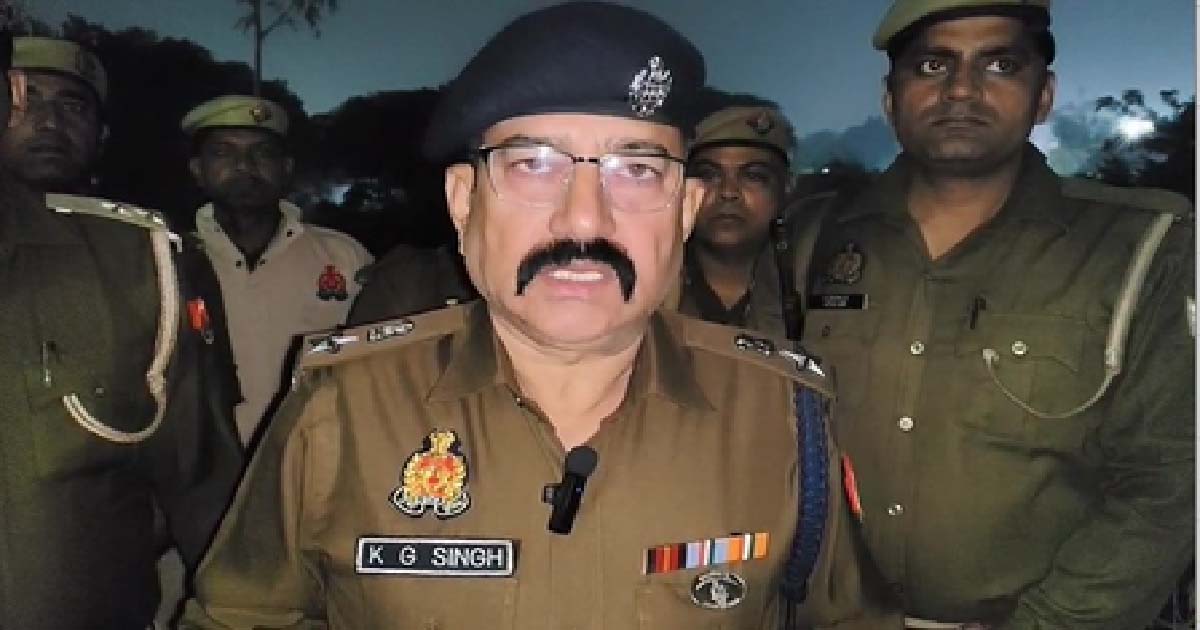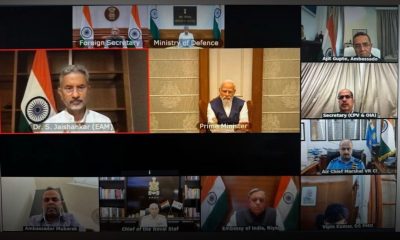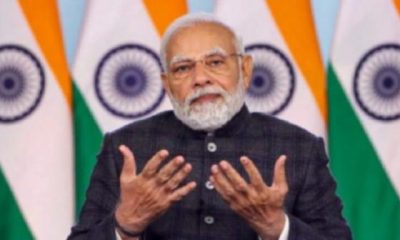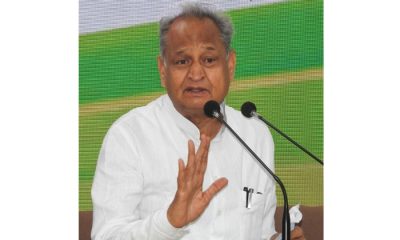National News
Modi appeals to farmers to adopt natural farming
Prime Minister Narendra Modi on Thursday once again appealed to farmers to adopt natural farming and also called for strengthening the dairy sector.
The Prime Minister, who was in Varanasi to inaugurate the Banas Dairy Kashi Sankul at Karkhiyaon, said that natural farming required less inputs, gave better output and was more beneficial because it earned higher returns.
“This method will make farming ‘atmanirbhar’. Those working in startups should also explore possibilities for this,” he stated.
Talking about the dairy sector, he said that the cow is our mother and held in high esteem. Those who ridicule this concept should know that India produces milk worth Rs 8.5 lakh crore every year which is more than the production of wheat or rice.
He said that in villages, cows were a sign of prosperity.
“We need to strengthen the dairy sector. The Banas Kashi Sankul will benefit dairy farmers from several adjoining districts. The dairy plant will also have a bio-gas plant that will take care of its power needs. The dairy farmers will now be able to sell cow dung for the bio-gas plant at a good price,” he said.
The Prime Minister said that milk committees and collection centres would be set up and certification of purity would also be done.
“Now the sweets of Banaras will taste sweeter – whether it is lassi or chhena sweets or ‘malaiyo’ in winter. The dairy plant will enhance the taste of Banaras,” he added.
He will also inaugurate and lay the foundation of 22 other projects.
The Prime Minister was in Varanasi earlier on December 13 to unveil the Kashi Vishwanath Dham Corridor project.
According to the official spokesperson, Modi will also digitally transfer a bonus of about Rs 35 crore to the bank accounts of more than 1.7 lakh milk producers associated with the Banas Dairy.
The Prime Minister said that the double engine governments had ensured double development, and this was obviously unacceptable to ‘some people’ whose politics was based on ‘mafiawad’, parivarwad’ and ‘jaatiwad’.
Earlier, the Prime Minister launched a portal and a logo dedicated to the Conformity Assessment Scheme of milk products, developed by the Bureau of Indian Standards (BIS) with the help of the National Dairy Development Board (NDDB).
The unified logo, featuring both the BIS logo and the NDDB quality mark, will simplify the certification process for the dairy sector and reassure the public about dairy product quality.
In another effort to reduce the number of land ownership issues at the grassroots level, the Prime Minister also virtually distributed the rural residential rights record, “Gharauni”, under the Swamitva scheme of the Union Ministry of Panchayati Raj to over 20 lakh residents of Uttar Pradesh.
Crime
Criminal with Rs 50,000 bounty killed in police encounter in UP’s Hapur

New Delhi, Nov 10: A notorious history-sheeter carrying a Rs 50,000 reward, identified as Haseen, was killed in a police encounter in Kapoorpur area of Uttar Pradesh’s Hapur district.
The encounter took place when police intercepted him during a late Sunday night checking operation after receiving a specific intelligence input about criminal movement in the area.
According to police sources, the accused, who had more than 25 criminal cases registered against him, was allegedly planning an incident of cow slaughter (gokashi) when the police team tried to stop his vehicle. Instead of surrendering, Haseen opened indiscriminate fire on the police team. In retaliatory firing, the accused sustained gunshot injuries and later succumbed to his wounds.
Police officials recovered a pistol and a vehicle (Swift Dzire) from the encounter site. The body has been sent for post-mortem, and a detailed investigation has been initiated.
Superintendent of Police, Hapur, Kunwar Gyananjay Singh, while briefing, said: “At around 12.30 a.m. last night, we received a tip-off in the Thana Kapoorpur area about the movement of a group of suspects. Acting on this information, the Station House Officer of Kapoorpur Police Station, along with his team, proceeded towards the indicated location. During the check, they spotted a suspicious Swift Dzire car and tried to stop it. The car’s occupants fired at the police team, and the police retaliated in self-defence.”
He added, “In the exchange of fire, one of the assailants was severely injured. He was rushed to the Community Health Centre in Dhulana and later referred to Rama Medical College, where doctors declared him dead. The deceased was identified as Haseen, a resident of Manotta village under Ashmoli Police Station in Sambhal district.”
Singh mentioned that there are about 25–26 criminal cases registered against him, including serious charges such as robbery, assault, and illegal arms possession. “He was a wanted criminal with a Rs 50,000 bounty announced by the police. A pistol, live cartridges, and a car have been recovered from the spot. Further investigation is underway,” he added.
Police officials confirmed that Haseen was a notorious criminal active across western Uttar Pradesh and had been evading arrest for several months. The Hapur police, along with the Special Operations Group (SOG), had been tracking his movements based on intelligence inputs.
The encounter marks another major success for the UP Police in their ongoing crackdown against hardened criminals in the region.
National News
Delhi Court To Pronounce Order On Framing Of Charges In Land-For-Jobs Case Involving RJD Chief Lalu Prasad Yadav And Family On December 4

New Delhi: The Rouse Avenue court on Monday deferred the order on framing a charge in a land for job corruption case. The court will pronounce an order on December 4.
CBI had filed charge sheets against former Railway Minister Lalu Prasad Yadav, Rabri Devi, Misa Bharti, Tejashwi Yadav, Hema Yadav, Tej Pratap Yadav and other accused persons. Special Judge Vishal Gogne deferred the order and listed the matter for December 4.
On September 11, the Rouse Avenue court had reserved its order on the charge in land for the job. This case is against former Railway Minister Lalu Prasad Yadav and others.
The CBI has charge-sheeted former Railway Minister Lalu Prasad Yadav, Rabri Devi, Tejashwi, and others in this case. It is alleged that jobs in the Railways were given instead of land.
Special Public Prosecutor (SPP) DP Singh had submitted on behalf of the CBI that there is sufficient material to frame charges against the accused persons.
During arguements, Former Railway Minister Lalu Prasad Yadav’s senior counsel, Maninder Singh, had argued that the land for the job case is politically motivated. There is no evidence to suggest that jobs were given to candidates in exchange for land. There are sale deeds which show that lands were purchased for Money.
Senior advocate Maninder Singh had submitted that there was no violation of any rule regarding the appointment, and no jobs were given for the land.
It was also argued that there was no recommendation by Former Railway Minister Lalu Prasad Yadav for any candidate. No General Manager has stated that he ever met Lalu Prasad Yadav.
The senior counsel had further argued that no case of corruption was made out as he had not made any recommendations for any candidate. Merely calling him a kingpin is not sufficient. There is no evidence against him.
It was also argued that no evidence to show that any land was taken for free. The land was purchased.
Earlier during arguements on behalf of Rabri Devi, it was submitted that Rabri Devi purchased land and paid money for it. Buying land for money is not a crime. No favour was given to any accused candidate. These transactions are not connected.
The senior advocate had submitted that the CBI had to prove the existence of corruption. The land sold was purchased for a consideration.
He had further submitted that all the due processes were followed by the applicants. Where is the corrupt practice? These acts are independent. No acts of the accused persons are connected, he added.
National News
PM Modi to lead ‘Dhwaj’ ceremony at Ram Temple on Nov 25, preparations underway: Nripendra Mishra

Ayodhya, Nov 10: Uttar Pradesh is gearing up for one of the most significant and symbolically charged events in its recent history, as Prime Minister Narendra Modi is set to hoist the Dhwaj (flag) atop the spire of the grand Ram Temple in Ayodhya on November 25.
The flag, according to temple officials, will be saffron in colour and bear the symbol of the Sun, representing the eternal energy and glory associated with Lord Ram.
Speaking to reporters, Ram Temple Construction Committee Chairman Nripendra Mishra said, “The discussions and preparations are focused on the Prime Minister’s program. We are ensuring proper arrangements for his visit so that he can tour the temple premises and review all ongoing construction works. The plan will be finalised based on suggestions from the Prime Minister’s Office.”
The main temple structure, along with six subsidiary shrines dedicated to Lords Mahadev, Ganesh, Hanuman, Suryadev, Maa Bhagwati, Maa Annapurna, and Sheshavatar, has been completed.
“Most of the work is completed. Now the attention is being paid to the beautification of the temple premises, including the plantations,” Mishra added.
On the upcoming flag-hoisting ceremony, he said, “We want the flag to be hoisted atop the temple’s main spire, and for that, certain technical requirements are being examined. Experts from the Defence Ministry, who specialise in such work, are assisting to ensure that the ceremony on November 25 goes smoothly without any issues.”
Ayodhya’s urban transformation has also taken shape around the temple’s spiritual and cultural significance. The newly redeveloped ‘Ram Path’, ‘Bhakti Path’, and ‘Dharma Path’ have been designed to guide devotees seamlessly from the city’s edges to the sanctum of the temple, weaving the story of Lord Ram into the very fabric of the city’s modern layout.
The government’s investment in Ayodhya and related pilgrimage infrastructure has been extensive.
An allocation of Rs 4,560 crore has been made to upgrade and strengthen roads linking key religious destinations such as Ayodhya, Varanasi, Mathura, Chitrakoot, and Prayagraj.
Additionally, Rs 4,200 crore has been earmarked to develop the Buddhist Circuit encompassing Sarnath, Kushinagar, Shravasti, Kaushambi, and other prominent stupas and tirthas across the state.
The November 25 ceremony is expected to be a moment of profound cultural and historical resonance, blending spirituality with the vision of a modern, developing Ayodhya, underlining the union of devotion and development.
-

 Crime3 years ago
Crime3 years agoClass 10 student jumps to death in Jaipur
-

 Maharashtra1 year ago
Maharashtra1 year agoMumbai Local Train Update: Central Railway’s New Timetable Comes Into Effect; Check Full List Of Revised Timings & Stations
-

 Maharashtra1 year ago
Maharashtra1 year agoMumbai To Go Toll-Free Tonight! Maharashtra Govt Announces Complete Toll Waiver For Light Motor Vehicles At All 5 Entry Points Of City
-

 Maharashtra1 year ago
Maharashtra1 year agoFalse photo of Imtiaz Jaleel’s rally, exposing the fooling conspiracy
-

 National News1 year ago
National News1 year agoMinistry of Railways rolls out Special Drive 4.0 with focus on digitisation, cleanliness, inclusiveness and grievance redressal
-

 Maharashtra12 months ago
Maharashtra12 months agoMaharashtra Elections 2024: Mumbai Metro & BEST Services Extended Till Midnight On Voting Day
-

 National News1 year ago
National News1 year agoJ&K: 4 Jawans Killed, 28 Injured After Bus Carrying BSF Personnel For Poll Duty Falls Into Gorge In Budgam; Terrifying Visuals Surface
-

 Crime1 year ago
Crime1 year agoBaba Siddique Murder: Mumbai Police Unable To Get Lawrence Bishnoi Custody Due To Home Ministry Order, Says Report


















